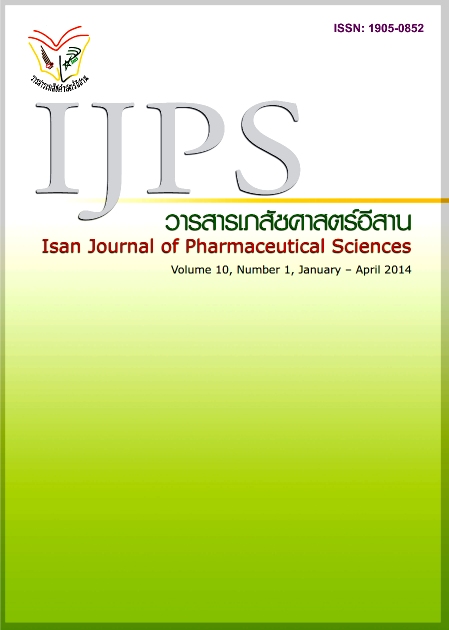Development and Evaluation of Computer Assisted Instruction for Basic Knowledge about Infectious Diseases
Main Article Content
Abstract
The objective of this study was to create and develops Computer Assistant Instruction (CAI) for 3rd year pharmacy students at Faculty of pharmacy, Chiangmai University. The study was one group pretest-posttest design. The CAI consisted of three topics: Epidemiology and etiology of infectious disease, clinical presentation and diagnosis, and laboratory test. After completion of 2- hour traditional lecture in class, pharmacy students were invited to complete the pretest which consisted of 8 multiple choice questionnaires about their knowledge then the CAI were implement. After finishing CAI, the students completed the posttest and the survey evaluated students’ perception of the effectiveness of the CAI using 3-level Likert scale: 3=good, 2=fair, 1=poor. The survey consists of 5 aspects 1) CAI content 4 questions 2) illustration 2 questions 3) sound 2 questions 4) language 2 questions 5) presentation 2 questions. From 145 subjects, 75.2% were female. Results indicated that the students’ perception for CAI were in a good level (>80%) for almost aspects except the difficulty of course contents and the speed of narrator. The comparison of knowledge by using pair t-test indicated significantly different between the average score before and after using CAI (5.02±1.45 vs. 7.06±0.96: p<0.005). In additions, students expressed their desire to use CAI programs for other pharmacotherapy lectures. In conclusion, the introduction to antimicrobial pharmacotherapy CAI program in combination with traditional lectures was effective and overall students’ perception was in a good level. In the future, CAI should be implementing and probably is valuable in pharmacy education.
Article Details
In the case that some parts are used by others The author must Confirm that obtaining permission to use some of the original authors. And must attach evidence That the permission has been included
References
Cain J, Robinson E. A primer on audience response systems: current applications and future considerations. Am J Pharm Educ 2008; 72: 1-6.
Chaiwarith R, Nuntachit N, Chittawatanarat K, et al.Surveillance of Antimicrobial Resistance among Bacterial Pathogens Isolated from Hospitalized Patients at Chiangmai University Hospital, 2006-2009. J Infect Dis Antimicrob Agents 2011;28: 35-44.
Chanakit T, Kunwaradisai N, Singkhan P, et al. Computer-aided Learning for Medical Chart Review Instructions. Afr J Pharm Pharmacol 2012; 6: 2061-2067.
Chisholm MA. An Internet- based Program to Teach Osteoporosis. Am J Pharm Educ 2002; 66: 416-420.
Chisholm MA, Dehoney J, Poirier S. Development and Evaluation of a Computer-assisted Instructional Program in an Advanced Pharmacotherapeutics course. Am J Pharm Educ 1996; 60: 365-369.
Harrold MW, Newton GD. Development and Evaluation of Computer-based Tutorials in Biochemistry and Medicinal Chemistry. Am J Pharm Educ 1998;62:24-30.
Keane DR, Norman GR, Vickers J. The Inadequacy of Recent Research on Computer-assisted Instruction. Acad Med 1991;66:8, 444-448.
Kunwaradisai N, Chanakit T, Saentaweesook N, et al. Evaluation of Computer Assisted Instruction in Basic Knowledge and Phar¬macotherapy for Smoking Cessation. IJPS 2010; 6: 18-29.
Mehvar R.Computer-assisted Generation and Grading of Pharmacokinetics Assignments in a Problem Solving Course. Am J Pharm Educ 1997; 61: 436-441.
Phimarn W, Pimdee A, Cushnie B. The evaluation and development of computer-assisted instruction program in pharmacology: Antiepileptic drug. IJPS 2013; 9: 50-59.
Reinhold J, Pontiggia L, Angeles M, Earl G. Web-based Instruction on Substance Abuse and Drug Diversion. Am J Pharm Educ 2010; 74(4), 57.
Suriyakrai S.Learning Styles of Pharmacy Students: Theory and Finding. IJPS 2011; 6: 18-29.
Zlotos L, Kayne L, Thompson I, Kane KA, Boyter A. A web-based Tool for Teaching Pharmacy Practice Competency. Am J Pharm Educ 2010; 74: 27.


